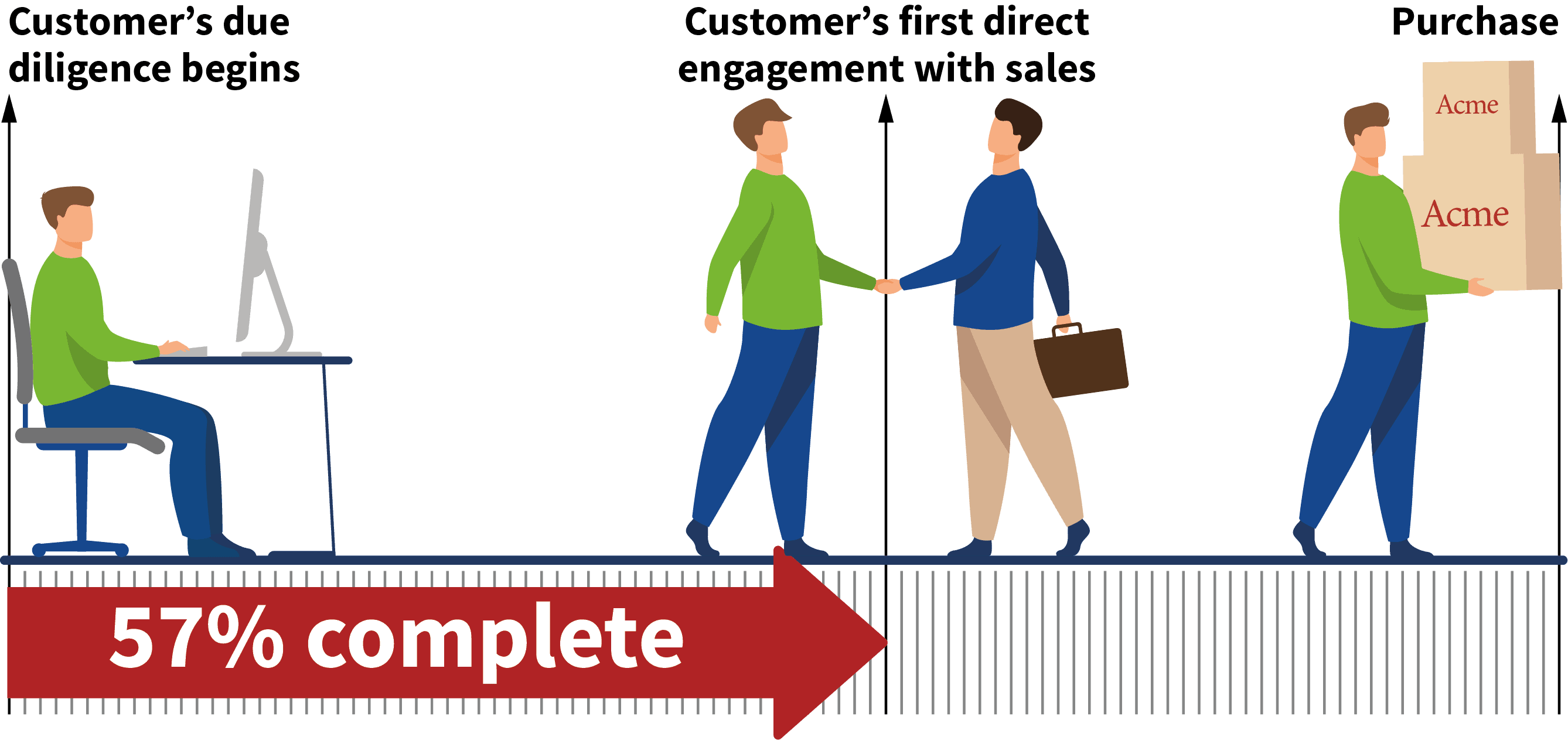B2B customers make most of their buying decision before engaging sales
This idea is further supported by a benchmark study of 1,400 businesses which found that organizations where marketing and sales were aligned closed 38% more proposals than non-aligned businesses and lost 36% fewer customers than their competitors.2
Customer progress through the purchase process before directly engaging a supplier sales rep1

Google and CEB’s survey of more than 1,500 B2B customer contacts found buyers were, on average, getting more than halfway through their purchase decision-making process before directly engaging a supplier sales representative.1
Where are prospects getting their information?
The good news for marketing and sales is that even when prospects are gathering information on their own, they are primarily obtaining it from “owned” media — sources controlled by the supplier company. This provides a tremendous opportunity to shape perceptions of the brand before the prospect engages with sales.
Ranking of information sources for considered purchase decisions3

In a survey of more than 400 B2B decision-makers, respondents were asked to rank information sources on a scale from 1 (Not at all important) to 5 (Very important.) Five of the top six sources of information ranked as highly important were all “owned” media channels under direct control of the supplier company.3
EXECUTIVE SUMMARY
- A recent survey reveals B2B buyers are getting more than halfway through the purchase decision-making process before directly engaging with a supplier sales representative.
- Most of the information prospects are accessing during the pre-sales stage is “owned” media under direct control of the supplier organization, presenting an opportunity to shape positive perceptions of the brand.
- When messages received during the pre-sale stage and the sales representative engagement stage are aligned, the prospect’s experience with the brand is more consistent and credible, which can help with sales conversion.
How can B2B marketers make the most of the 57%?
These studies highlight the need for organizations to pay careful attention to the messages their customers and prospects receive through their owned media, including their sales force. The messages customers receive during the research stage determine whether they will move forward in the buying process. Those messages must be consistent and credible. If the customer does decide to proceed and engage sales, sales messaging must be aligned with what the customer has already learned (and based most of their decision on). A lack of message consistency at this stage can cost the brand not only credibility, but possibly sales.
Misalignment can lead to dissatisfaction
B2B buyers are reporting increased dissatisfaction with the sales process. A 2012 buyer behavior survey of 170 B2B purchasers found the number of respondents who were dissatisfied with their B2B purchase experience grew from 36% in 2011 to 56% in 2012.4 This may suggest the sales follow-through process is not living up to the expectations customers are forming from the pre-sale research stage.
Knowing that customers make more than half of their buying decision before engaging sales means marketers must make the most of the information customers access during the research phase. Consistent, credible owned media creates a positive brand impression that can help customers move to the next stage of the process — engaging sales. At this stage, if sales messaging is aligned to what the customer has already learned (and already likes), there is more opportunity to successfully close the sale.
Understanding owned media
Owned media is what you say about yourself. It’s any media that is under your direct control. Examples include:
- Employees and sales force
- Website
- Sales materials/detailers
- Product packaging
- Business cards and stationery
- Building and signage

1 The Corporate Executive Board Company Marketing Leadership Council in partnership with Google. 2012. The Digital Evolution in B2B Marketing. Retrieved from http://www.executiveboard.com/exbd-resources/content/digital-evolution/pdf/Digital-Evolution-in-B2B-Marketing.pdf.
2 Macfarlane, Hugh. 2005. Sales & Marketing Alignment. Retrieved from http://www.mathmarketing.com/b2b-marketing-resources.html.
3 TriComB2B in partnership with the University of Dayton School of Business Administration. 2011. The Considered Purchase Decision: What Matters, What Doesn’t and What It Means for B2B Marketing and Sales. Retrieved from http://www.tricomb2b.com/sites/default/files/TriComB2B-UD_MedicalDevice_Pharm.pdf.
4 Demand Gen Report. 2012. The 2012 B2B Buyer Behavior Survey: New Challenges, New Complexity. Retrieved from http://www.demandgenreport.com/industry-resources/research/1782-the-2012-b2b-buyer-behavior-survey.html.
